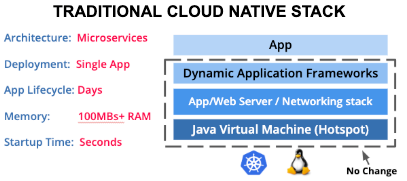
It is becoming increasingly apparent that containerization in general and Kubernetes in particular is forcing a re-evaluation of Java for the development of cloud native applications. Kubernetes is a highly dynamic shared infrastructure that becomes more cost effective as the number of applications a cluster can host grows and the responsiveness to application lifecycle changes improves, like redeployments and scaling up/down. Traditional Java cloud native runtimes have layered new functionality on an existing stack, without really re-thinking the underlying stack itself. This results in larger memory consumption and slower startup times, to the point where organizations are now willing to forgo their deep Java expertise to retrain and retool for Go and Node.js to drive more value out of their large investment in Kubernetes clusters.

This is the very problem that Quarkus addresses.
Quarkus is optimized for memory density and rapid startup time. Quarkus applications running on the JVM can deliver nearly twice as many application instances in the same amount of RAM when compared to other cloud native Java stacks, and up to 7x more instances when packaged as a native binary. This is more than simply compiling to a native binary using SubstrateVM (a feature of GraalVM). Quarkus has optimized traditionally “highly dynamic” frameworks for Kubernetes immutable infrastructure, resulting in reduced memory utilization and faster initialization. These optimized and well-documented frameworks, called “extensions”, consist of best of breed and standard APIs. The result is significant improvements in runtime efficiency.
Read more: https://quarkus.io/blog/quarkus-for-spring-developers/
Credits : https://quarkus.io/blog/quarkus-for-spring-developers/
Comments
Post a Comment